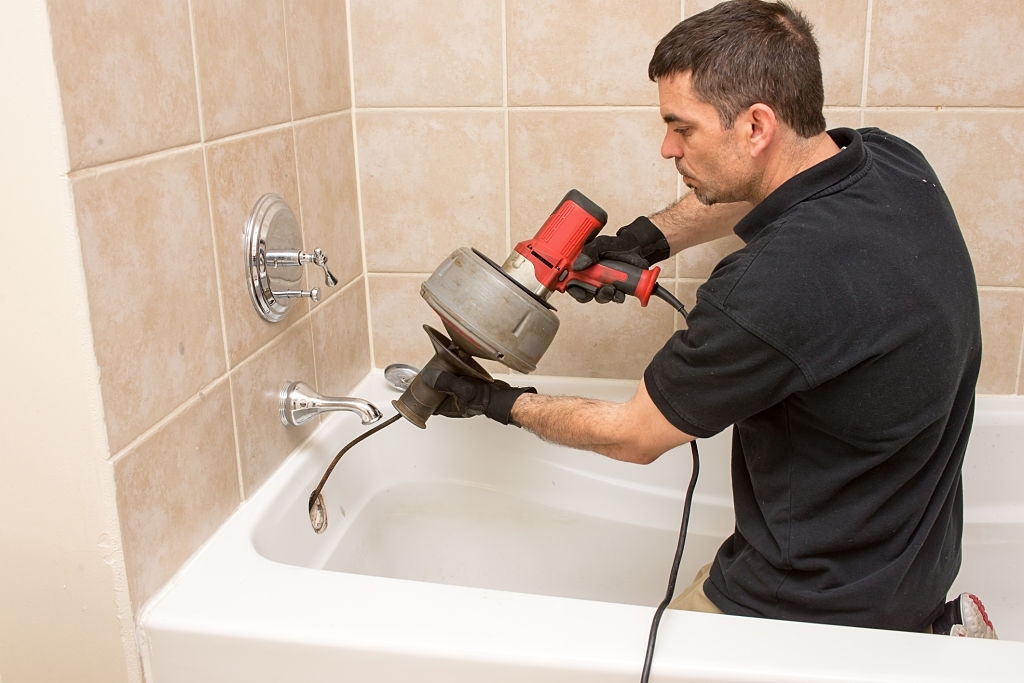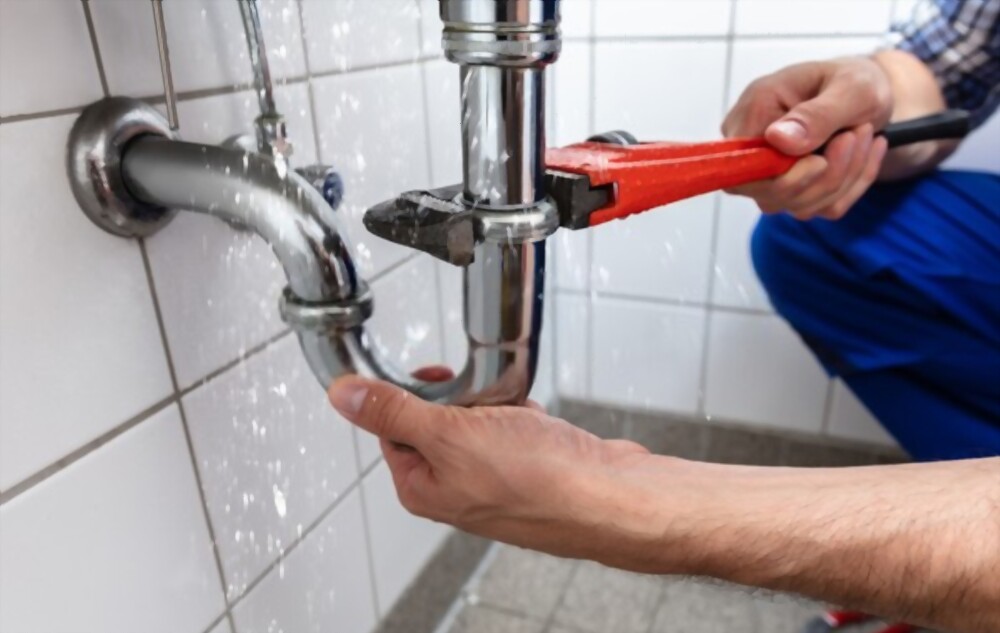Are you a homeowner who is doing some plumbing repairs yourself? Or maybe you’re a plumber who is looking for some new equipment to add to your tool box. Either way, having the right tools can save you time and money, while also preventing frustration. In this blog post, we will share our top picks for the best plumbing tools and equipment to own.
Plumbing Tools Checklist

Note: Every plumber will have slight differences in the tools they use. We included the most common ones on our list. If you feel like we missed a tool feel free to let us know and we can add it to the list.
Clogged Pipes/Drains
- Plunger
- Drain Snake
- Electric Drain Cleaning Machine
- Drain Inspection Camera
Pipe Work
- Pipe Cutter
- Hacksaw
- Press-Fitting System
- Thread-Sealing Tape
- Pipe Reamer
- Pipe Threader
- Crimper
- Plumbing Pliers
- Flaring Tool
- Deburring Tool
- Pipe Squeeze Off Tool
- Taping Compound
- Plumber’s Torch
- PVC Primer
Wrenches
- Pipe Wrench
- Basin Wrench
- Sillcock Key
- Torque Wrench
Best Plumbing Tools for Clogged Pipes & Drains

Plunger
A plunger is a tool that fits over the drain opening of sinks, bathtubs, or toilets in order to create a vacuum seal so pressurized water can push blockages through them. A skilled plumber will know the right amount of pressure to apply when plunging something like a sink or toilet in order to clear out whatever’s blocking it without doing any damage, but when plungers don’t work the next step might be using drain snakes instead.
Drain Snake
A drain snake is a plumbing tool that consists of either flexible wire cables or spiral blades inside an insulated handle. They’re inserted into drains through their openings in order to make contact with whatever’s causing a blockage; then they’re either manually turned (in the case of spool-type drain snakes) or twisted (in the case of cable-style drain snakes). Either way, they’re designed to break up and push through clogs that otherwise would require a plunger or full plumbing snake service.
Electric Drain Cleaning Machine
An electric drain cleaning machine is a tool used by plumbers to clear out clogs in drains that are otherwise too far down the plumbing line for other devices to reach. They’re also known as power augers because they consist of either an electric or gas-powered engine that rotates one or more snake cables at high speeds in order to break up and clear away hard blockages.
Drain Inspection Camera
A drain inspection camera is a hand-powered plumbing tool that enables you to see the condition of your pipes without having to remove them from the floor or ceiling. Drain inspection cameras can be either flexible or semi-rigid, and many have bright lights at the tip so you can see what’s going on inside dark drains.
Best Plumbing Tools for Pipe Work

Pipe Cutter
A pipe cutter (also called a tubing cutter) is a hand tool that cuts through metal and plastic pipes, tubes, and hoses. A plumber uses a pipe cutter to prepare the ends of the pipes for joining them together with solvents or threading them onto fittings.
Hacksaw
A hacksaw is a tool with a long, narrow metal blade inside of a frame equipped with both wood and metal handles. A hacksaw is used for cutting through metal objects such as pipes or even certain metals like aluminum where regular saws won’t work.
Press-Fitting System
A press-fitting system is a plumbing tool that is used to join pipes without the need for solder or solvent welding. A press-fitting system relies on different types of fittings and pressure from washers, clamps, or stainless steel straps in order to create a watertight seal between two pipes.
Thread-Sealing Tape
Thread-sealing tape is a type of Teflon tape that is used to create a watertight seal between two pipe threads. Thread-sealing tape is wrapped around one end of a pipe and then threaded onto another. Plumbers use thread sealing tape so they can join pipes together without having to add additional plumbing fittings such as couplings or unions, which helps conserve time and money.
Pipe Reamer
A pipe reamer is a metal tool with a long, slender shaft used to enlarge the inside diameter of metal pipes. Plumbers use pipe reamers when they’re joining two metal pipes together at their threaded ends because it enables them to get a threaded joint that’s watertight by cleaning up burrs left behind from cutting or sawing metal.
Pipe Threader
A pipe threader is a plumbing tool that consists of a handle, spindle, and die with internal grooves. The grooves correspond to the number of threads per inch on different size pipes; in order to join threaded pipe ends together it’s necessary for the threads inside each side to match so they can be screwed tightly together. Pipe threaders are used by hand or with an electric drill, but when working with PVC piping it’s preferable to use them manually so the force being applied doesn’t strip out or damage the plastic fittings.
Crimper
A crimper is a plumbing tool that’s used to cut and bend tubing while joining the ends of two different types of metal piping. In this way, they’re similar to pipe threaders, but enough force has to be applied by hand in order for them to work properly. When done correctly, crimping metal pipes creates a watertight seal so any fluids passing through them won’t leak out from unexpected places along their path.
Plumbing Pliers
Plumbing pliers are tools with handles on either end of long metal jaws which can be used to bend, crimp, or hold pipes while the other end is inserted into attached fittings. Since there are many different types of plumbing pliers they’re also known as combination pliers because they can grip onto anything from small to large pipes and tubing at the same time.
Flaring Tool
A flaring tool is a type of tube bender that cuts and flares the end of a related-sized piece of metal tubing or piping instead of just bending it into place at an angle. This allows for the insertion of fittings as couplings which can be securely tightened inside the piping with a special crimping tool.
Deburring Tool
A deburring tool is a type of hand-held device that’s primarily used to remove burrs from metal and plastic tubing or piping. After it’s inserted into one end of a metal tube or pipe to be deburred, the other end is then pulled through in order to grind away any raised edges or uneven surfaces.
Pipe Squeeze-Off Tool
A pipe squeeze-off tool is a hand tool that’s used to close off the open end of a tube or piping system by compressing its inner surface. This is to stop the water from entering through the pipe.
Taping Compound
Taping compound, also called joint compound, is an adhesive plaster that can be spread onto drywall or pipe surfaces before another material (such as tape) is applied to the seams. Plumbers use taping compound when installing PVC pipe because it creates a watertight seal around the inside walls of the pipes by filling in any gaps between them. Taping compound can also be used to cover up existing holes in drywall caused by electrical wiring or plumbing.
Plumber’s Torch
A plumber’s torch is a plumbing tool older style of torches used to solder metal pipes. Modern versions of these torches are still in use today but their primary purpose is heating and soldering copper fittings, not for soldering the ends of pipes together.
PVC Primer
PVC primer is a solvent that enables joint compounds such as PVC glue or cement to stick to PVC pipe and fittings more readily. It’s available in both aerosol spray cans and larger containers, and it can also be used to clean off old glue from drain pipes so new adhesives will stick better.
Plumber Wrenches

Pipe Wrench
A pipe wrench has a hollow body with one open end and serrated jaws designed to close around metal or plastic pipes. Pipe wrenches come in single-pipe and double-pipe models; both are adjustable so they can fit any size pipe and prevent damage due to over-tightening. Plumbers use pipe wrenches when installing new fixtures such as faucets because they’re able to tighten and loosen nuts and bolts quickly.
Basin Wrench
A basin wrench is an adjustable tool designed to loosen and tighten nuts and bolts that connect pipes to plumbing fixtures; they can also be used to loosen and tighten the locknuts that secure faucet stems in place. There are two types of basin wrenches: single-hook and double-hook. A single-hook wrench has one open end with a narrow hook projecting from it, whereas a double-hook wrench has two hooks on either side of the open end so you can grip nuts or bolts from different angles.
Sillcock Key
A sillcock key is a plumbing tool that’s used to turn on or off the water supply to a household kitchen sink, specifically to the outside spigot. While most sillcocks are round, they can also be long-handled for easier access to them while standing on a stepstool.
Torque Wrench
A torque wrench is a plumbing tool that’s used to tighten bolts, nuts, and screws in any application where they need to be tightened to a specific amount in order for them to perform correctly. It consists of a long metal handle attached to either end of what’s known as a beam that’s easily maneuvered by applying pressure to the handle at different angles.
What are plumbing tools?
Plumbing tools are devices used to install and repair different types of fixtures, appliances, and utilities. Plumbing tools can be electrical-powered or hand-powered, and serve different functions depending on the task a professional plumber (or homeowner) needs to accomplish.
Owning the right plumber tools means you’ll always be prepared for any unexpected repairs. Here are some plumber tools needed for plumbing repairs.
How much do plumbing tools cost?
The cost of plumbing tools varies depending on what type they are, but generally speaking, hand tools only cost a few dollars to buy. Power tools that require electricity or gas to run can be higher in price since these components also need maintenance along with them; however, since many people rent them it’s usually not necessary to pay for their purchase price upfront.
Where do I buy plumbing tools?
You can buy plumbing tools online through Amazon, Home Depot, and other home improvement retail websites. In addition, you can visit your local hardware or home improvement store and find most of the plumbing tools you’ll need for a project.
How to use plumbing tools?
First, start by collecting all of the required plumbing tools. This may include things like wrenches, pliers, soldering irons, screwdrivers, tubing cutters, channel locks, or any other specialized equipment that you will need for your specific project. Next, familiarize yourself with each tool individually so that you know how to properly use them. And finally, before beginning any project, take a few moments to carefully plan out your approach and think about how each step of the process might impact your final results. Be sure to clean up any tools or equipment that you use after your project is completed.
Can you recycle plumbing tools?
Although we often think of recycling as something we do with paper or plastic, there are actually many items that can be recycled and reused. This includes plumbing tools and materials. Pipes, fittings, and even old toilets can be recycled and used in new construction projects. In fact, using recycled plumbing materials is one way to reduce your environmental impact. Not only does it conserve resources, but it also reduces the amount of waste that goes into landfills.
How to recycle plumbing tools
There are a few different ways to recycle plumbing tools. The first is to return them to the store where they were purchased. Many hardware stores have programs in place that allow customers to recycle used fixtures and tools. Another option is to contact a local recycling center. Many centers will accept plumbing fixtures and tools, as well as other types of scrap metal. Finally, it’s also possible to sell used plumbing tools online. There are a number of websites that specialize in buying and selling recycled materials.
Can you disinfect plumbing tools?
Yes, you can disinfect your plumbing tools as long as do it correctly and carefully. You should always read the manufacturer’s instructions before disinfecting your tools.
How to disinfect plumbing tools?
There are a few different ways to disinfect tools, but the most common method is to soak the tools in a bleach solution. To make a bleach solution, mix one part bleach with nine parts water. Then, place the tools in the solution and let them soak for at least five minutes. After five minutes, remove the tools and rinse them off with clean water.
Another way to disinfect tools is to spray them with a commercial disinfectant designed for use on plumbing tools. Make sure to follow the instructions on the label for proper use.
How do you store your plumbing tools?
There are a variety of ways to store plumbing tools, depending on your needs and preferences. One popular method is to use a tool bag, which allows you to easily transport your smaller tools from one job site to another. Alternatively, some people prefer to keep their larger plumbing tools in their truck or van, so that they can easily access them whenever they need them.







